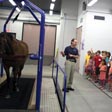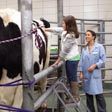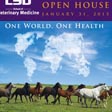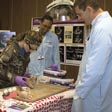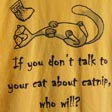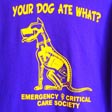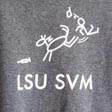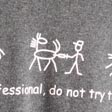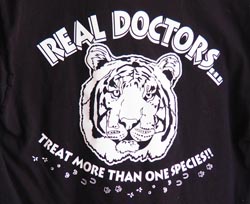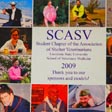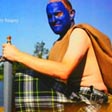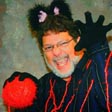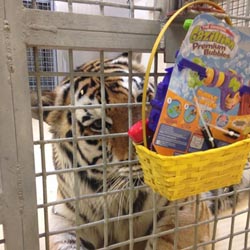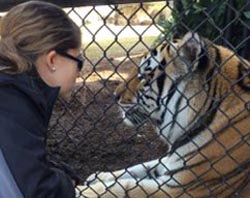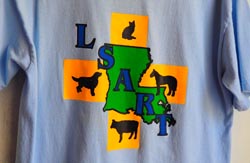Real Doctors: Folk Traditions of LSU Vet School
By Carolyn Ware
Each year since 1979, the LSU School of Veterinary Medicine (SVM) has opened its doors and grounds to the public for a daylong Open House, usually held on a Saturday in late January or early February. From 9:00 in the morning until late afternoon, long lines of visitors follow the "Paw Print Trail," a self-guided tour through the teaching hospital's corridors, barns, treatment rooms and diagnostic areas. Dozens of educational exhibits, demonstrations, and hands-on activities along the way reveal various aspects of animal health and medicine. Vet students, who have created many of the interactive exhibits, stand by to offer information and guide children through activities such as learning how to "scrub up like a surgeon," meeting raptors (birds of prey) up close in the school's wildlife hospital, using an ultrasound probe to search for olives hidden in a jello mold, watching a horse canter on a treadmill, and petting shaggy donkeys and goats, among other highlights. In addition to Vet School-sponsored demonstrations, a variety of animal rescue groups talk with visitors about their missions, offering brochures, t-shirts for sale, and the chance to pet a friendly Golden Retriever. Typically, the university's popular tiger mascot, Mike VI, also visits the event in his purple-and-gold trailer.
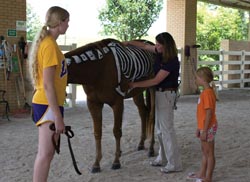
The Open House is a much-anticipated local tradition not only for SVM students and personnel, but for thousands of residents in the greater Baton Rouge area. For current classes of vet students, it is a chance to share their growing knowledge and educate the general public about their profession. For the general public, particularly children and animal lovers, it has become a prominent feature of local community life and pride. In 2014, for example, a record-breaking 8,000 people attended (LSU SVM 2014).
The annual Open House illustrates the many important roles the Louisiana State University's School of Veterinary Medicine (SVM) plays in the greater Baton Rouge community. One of 30 vet schools in the United States, it was established in 1967 and accepted its first class of 34 vet students, all Louisiana residents, in 1973. The program has grown significantly over the last four decades; the highly-competitive school now receives about 800 applications for admission annually, and accepts 89 students from Louisiana and throughout the U.S. The school has now educated and trained more than 2,700 veterinarians who have entered private veterinary practice, become academic researchers, and worked in public health as well as in biotechnology and pharmacology (LSU SVM 2015). The SVM also has its own news magazine, La Veterinaire, which offers profiles of faculty and alumni, event listings, and occasional "A Day in the Life of a SVM Veterinarian" articles.
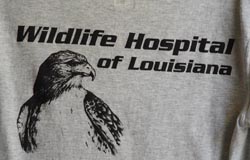
As a teaching hospital, the SVM not only offers vet students crucial clinical experience, but also provides cutting-edge medical and surgical treatment for thousands of animals in South Louisiana and neighboring states each year. The Veterinary School building, across the River Road from the Mississippi River levee, houses large animal (horses and livestock) and small animal (companion animal) clinics, as well as the new Louisiana Wildlife Hospital, a mobile hospital ready to respond to hurricanes or other disasters, a veterinary library, classrooms, and labs. Specialty departments include ophthalmology, cardiology, oncology, and dermatology, among others; the hospital also offers physical therapy and alternative medical practices such as acupuncture. The vet school clinics are a valuable resource for primary animal care such as routine vaccinations and wellness exams, as well as specialized diagnosis and treatment using the latest medical technologies, and emergency medical services after hours and on weekends.
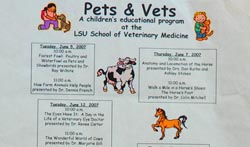
In addition to these important medical contributions, the vet school provides numerous forms of community service, including an educational summer program for children called "Pets and Vets," a popular annual "Animals in Art" exhibit, and broader initiatives aimed at educating the general public about responsible pet ownership, animal welfare, and the importance of spaying and neutering in decreasing the number of stray animals in the region. One initiative is Spay Day, which typically takes place nine times a year. On Spay Day Sundays, dozens of community veterinarians, technicians, vet students, and animal rescue groups volunteer their time and skills to ensure that as many as 200 cats, including feral and rescued cats, are spayed and neutered. The program began in 2007 with a grant of $800,000 from the Humane Society of the United States intended to "help communities affected by Katrina" and to offer "real-world training" for vet students as well as "an opportunity to make a lasting, positive on the future of animals and the communities that they will help" (LSU SVM 2007:12).
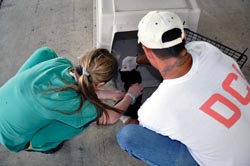
This essay presents a sampling of folk traditions associated with the LSU School of Veterinary Medicine, particularly those of its students, clinical faculty, nurses, and other workers. It begins with the perspectives of veterinary students during the classroom phase of their studies, as they begin learning about their chosen profession and its demands. Their folklore reflects the intensity of this phase with its emphasis on digesting volumes of information, cramming for exams, bonding with classmates, and learning to think of themselves as veterinary professionals. As students move from the classroom to clinical rotations in the middle of their third year, they become part of the larger hospital culture and its work-related folklore, the focus of the latter part of this article.
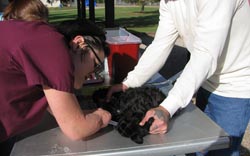
Many SVM traditions are "insider" traditions: stories, jokes, rituals, celebrations, and other traditions that emerge out of everyday life and memorable events in veterinary classrooms and clinics. Others, like the annual Open House, are also aimed outwards to a larger public, sharing aspects of veterinary life and culture with visitors and encouraging them to learn more. A few, such as the vet school's stewardship of the university's live tiger mascot, affect the entire LSU community. Similarly, vet school personnel's leadership in responding to animal victims of Hurricane Katrina in 2005 has changed how the state prepares for disasters, and led to a new program in shelter medicine at the SVM. In response to these extraordinary experiences, the SVM community has created and shared new narratives and other expressive traditions.
Occupational Folklore and Veterinary Medicine
A number of excellent studies by folklorists, sociologists, and other scholars have examined the occupational culture of medicine (for example, Coser 1959, Dundes 1961, Becker et al. 1976, Bosk 1979, Burson-Tolpin 1982, 1990; Hufford 1989; Gabbert and Salud 2009). In contrast, the oral, material, and customary traditions of veterinary medicine have received little scholarly attention, although a number of veterinarians have written their own memoirs and observations on their work (for example, Herriot 1972 and Trout 2008). While veterinary folklore has much in common with that of medical schools and hospitals, there are important distinctions between "human" medicine and veterinary medicine. The most fundamental difference is that human-animal relationships lie at the core of veterinary medicine and shape virtually every aspect of its practice. As folklorist Jack Santino writes of occupational narratives in general, veterinary medical personnel create and share a rich variety of folk traditions "provide insight into and an index of the specific challenges and problems that arise" in their work (Santino 1978:70). Occupational folklore not only expresses the values and experiences of the work, but helps to teach and assimilate new members such as veterinary students.
Starting Out
Each August, a new class of more than 80 veterinary students begins a three-day orientation at the School of Veterinary Medicine. By design, students are an increasingly diverse group in terms of age, ethnicity, life experience, and other factors. They are generally high achievers academically; after all, the limited number of veterinary schools in the United States makes gaining admission to a veterinary program more difficult than getting accepted into most medical schools. Most entering students have already earned an undergraduate degree, but applicants as young as 19 may be admitted after only two or three years of undergraduate work. A smaller number of students enter vet school in their late 20s, 30s, and occasionally their 40s, having worked previously in other occupations. Following a general trend in vet medicine over the last four decades, the percentage of female students has risen steadily, with women now comprising about 80 percent of recent students.
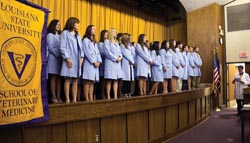
Beginning on the first day of orientation, SVM faculty and administrators work to build a sense of community and professionalism among classmates, who will spend much of their time together for the next four years. At the conclusion of orientation week, students' new professional identity is marked by a first-year coating ceremony in which students sign an oath of professional conduct and ethics, pledging to "help create an atmosphere conducive to education" by "promoting mutual respect" among SVM students and faculty members (SVM 2004). Students receive the blue lab coats they will wear for laboratory courses for the next two and a half years, Phase 1 of their training. This is only one of the many traditions that will define their vet school experience over the next four years.
Life in the Classroom
The first phase of veterinary education consists primarily of long hours of classroom lectures, practice labs, and preparing for exams. Each year has its own character and goals. First-year students must make the transition from an undergraduate environment to a professional school environment. For instance, students must realize that they are now members of a trusted profession, that "there are responsibilities that go along with that," and that individual students' actions affect others (Taboada 2007). They also need to learn how to organize their time and study effectively, skills that many excellent students have never had to really master before. "The material in the first year is not difficult," Associate Dean of Student and Academic Affairs Joseph Taboada said in a 2007 interview. "There's just a lot of it. . . . So that's one of the issues in the first year, transitioning into handling the volume, organizing themselves, and taking more responsibility for themselves" (2007).
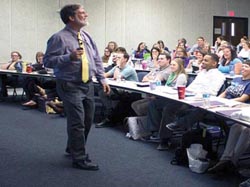
Because students generally spend more than 30 hours a week in classrooms and labs, the vet school building becomes a second home. Many pick a particular seat in the classroom during orientation, and sit in that seat for the next three years of lectures. Often they personalize their area by taping photos of their pets, family, or friends to the desktop, or velcroing a water bottle to a table leg. Dr. Taboada notes that when these students come back for programs after graduating, they will often return to that same seat.
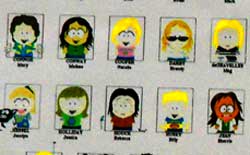
An important task in these early years is creating a sense of belonging to a group. Teamwork is crucial in modern veterinary practice, which is generally "not James Herriot riding around the countryside, for the most part," despite popular expectations (Taboada 2007). Faculty members lead team-building and leadership exercises during student orientation, for instance. Throughout their education, as class members spend many hours together studying, commiserating, and socializing, they form strong friendships and a shared sense of identity that endures long after graduation. Each class quickly develops a distinctive "personality" of its own, according to student lore. One class might be a "serious" class, for example, while another might be seen as laid-back or as partiers. This personality becomes the basis of insider jokes and other kinds of class traditions. An artistic member of the graduating class of 2007 created a mock photo roster of the class, which features South Park-type caricatures of each student in place of the official class photos.
The all-consuming nature of vet school, especially in these early years, can make it difficult for students to shift mental gears and socialize with non-vets. A female student, now a graduate, commented of herself and fellow students: "It's funny, because you'll hear people say, 'You know, I went to a wedding or a party, where there were no [other] vet students, and I had no idea what to talk about'" (Boehm interview 2006). Despite their workload, however, many vet students find time to socialize with each other at mixers, an occasional vet school "prom," weekly soccer games on the front lawn of the school, an annual crawfish boil, and other events. Like the larger LSU community, many vet students tailgate for home football games, gathering in front of the vet school to barbecue and relax.
Classroom Oral Traditions
A range of oral traditions play an important part in students' education and acculturation in the early years. Although veterinary education today stresses problem-based learning rather than sheer memorization, students are still required to absorb massive amounts of information during these years. Vet students create and pass down a variety of mnemonic devices, acronyms, and narratives that help them remember the torrent of new information—for example, remembering a sequence of numbers related to clotting factors (12, 11, 9, 8) by thinking of them as a discounted price, as $12 becomes $11.98.
Anecdotes, legends, and rumors also play a part in educating students, particularly stories about how not to behave. Instructors use stories about previous students' careless misbehavior to remind students to be careful and act professionally. As students repeat these stories among themselves, the outcomes often grow progressively more disastrous or embarrassing. In his memoir Tell Me Where It Hurts, veterinarian Nick Trout recounts a common urban legend he heard as a student at another vet school, in which a young surgical "wannabe" challenges a senior surgeon to a "spay race," only to discover that he's been trying to spay a male cat (2008:152). Similarly, a story of two students playfully squirting each other with bovine spinal fluid becomes more dramatic in retellings, and the cow is now suspected to be rabid. These tales are reminders of how each class member's actions can affect others, conveying warnings not to be "stupid" and overconfident, in one former student's words (Ware 2011). At the same time, they are entertaining and often funny.
Humor and Veterinary Education
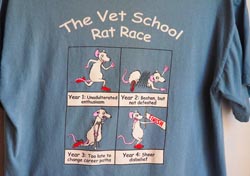
Humor plays a critical role in surviving the challenges and intense pressures of vet school. Students comment on and alleviate these experiences through jokes, comical sayings, practical jokes, and other outlets. Student-designed t-shirts, usually created and sold to raise funds for vet student associations, comically depict the stress and anxiety of vet school life. In a shirt titled the "vet school rat race," a cartoon rat progresses from first-year "unadulterated enthusiasm" to "beaten, but not defeated" in Year Two, to "too late to change career paths" in Year Three, and finally "sheer disbelief" in the fourth year, with the finish line finally in sight. Another reads "White coat, one way or another!" beneath the figure of a crazed man in a white straitjacket, a humorous reference to students' determination to earn the white coat that represents their status as doctors, or go insane trying.
Other t-shirts comment more generally on the veterinary profession. One student-designed shirt exclaims "Your dog ate what?," a reminder of the strange medical problems that all practicing veterinarians must handle with good humor. The popular slogan "Real doctors treat more than one species" suggests that veterinarians are more skilled than physicians because they must be knowledgeable about many kinds of animals, while M.D.s' expertise is limited to human beings. The saying also alludes to the fact that veterinary medicine is still considered by many to be less prestigious than human medicine, and qualified veterinarians generally earn less than physicians.
Faculty members often cooperate in vet student fundraisers, even when it entails poking fun at themselves (as it often does). To raise funds for the Student Chapter of the Association of Shelter Veterinarians, for instance, LSU vet students in the past have designed and sold thematic calendars featuring photographs of popular male faculty members. "The Men of LSU SVM" calendars in 2009 and 2010 feature male faculty members in mock cheesecake poses that humorously refer to personal characteristics. Sometimes these jokes allude to national stereotypes: a Scottish equine vet in a kilt and blue face paint becomes Braveheart, for example, and a French doctor poses in a beret, kerchief, and roses between his teeth. Other photos refer to clinical specialties or personalities, like the senior cardiologist dressed as a fuzzy-winged and bearded Cupid, holding up an enlarged image of an animal heart. Similarly, the Dean of Student and Academic Affairs, a cat lover, has posed as a hissing cat with a ball of yarn. This playful blurring of hierarchical lines reflects the fact that students, faculty, and administrators are all fellow members of the SVM community, and students will soon be full-fledged professional colleagues.
Customary Folklore in the Classroom
In addition to verbal and material traditions, vet students pass down or invent a range of customary traditions, both solemn and comical. Folklorists David Hufford (1989) and Anne Burson-Tolpin (1982) have described the significance of satirical variety shows staged by graduating students at most medical schools, and Hufford argues that these performances are a form of occupational folk drama that allows recent graduates to "ventilate openly . . . feeling and thoughts about their educators" (1989: 136). For some years, fourth-year LSU veterinary students scripted and performed similar roasts of their professors and vet school experiences, as well as talent shows. This tradition ended, an alumna says, when the individuals who enjoyed organizing these events graduated.
However, second-year LSU vet students still perform much shorter comical skits in their classrooms, particularly in a parasitology lab course. Although students create their own material, the conventions of the skit, including humorous role reversals, have been "passed down from class to class," a former student explained. In past performances, for example, a student skilled in mimicry impersonated various professors as she threw questions at her teammates, who responded with absurd answers. In other skits, students have costumed as sick or injured animal patients (a turtle hit by a car, in one instance) that teammates then comically diagnose and try to treat (Hutchens 2008). Many professors encourage and appreciate this creativity. A senior professor described, with amusement, a student skit that involved a mock trial in which the entire "jury" of students held fans printed with the professor's photograph in front of their faces, symbolically assuming his identity. Much briefer and far less transgressive than traditional faculty roasts, these brief comic dramas still allow students to laugh at their teachers, themselves, and other aspects of veterinary medicine.
Professional Passages: The White Coat Ceremony
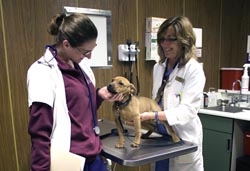
Other customary performances are more formal and celebratory. Particularly significant is the white coat ceremony, a contemporary rite of passage that marks vet students' transition from largely classroom study to hands-on clinical rotations in which they learn the actual practice of medicine. Since the early 1990s, white coat ceremonies have become a standard feature at most schools of medicine, veterinary medicine, and other health professions, a recognition of students as emerging medical professionals (Branch 1998, Huber 2003). At the LSU School of Veterinary Medicine, this shift occurs midway through the third year of vet school, usually in early February. In front of an audience of spouses, parents, mentors, and friends (many bearing congratulatory bouquets), a faculty mentor chosen by the student assists each vet student into a hip-length white coat embroidered with her or his name. The white coats symbolize students' new professional status and "the responsibility that they bear to the health and welfare of animals" (LSU SVM 2012:17). As then-SVM Dean Peter Haynes commented in the 2009 ceremony, it is a formal recognition of the third-year vet students' new status as medical professionals as they enter "the phase of the profession that really attracted all of you—the art and science of clinical medicine" (Ware field notes, February 2, 2009). With the beginning of clinical rotations, third-year students become hard-working members of the larger veterinary hospital community.
The World of the Veterinary Hospital
In the busy culture of the teaching hospital, traditions provide important ways to acculturate new members and maintain a sense of professional community as students, interns, and residents come and go on a regular basis. Traditional "ways of organizing people, places, and time," distinctive clothing, rituals, and expressive culture all "provide a bedrock of stability in the face of rapid surface change" (Burson-Tolpin 1990:76).
As folklorist Anne Burson-Tolpin writes, every hospital comprises "a variety of subcultures, some overlapping and others not" (1990:77). Central to every teaching hospital is a complex hierarchy based on rank, responsibilities, medical specialties, and other factors. At the SVM, this includes faculty clinicians (faculty members who teach and work in the clinics), house officers (interns and residents), a variety of veterinary nurses and technicians, front office staff, kennel workers, third-year students beginning their clinical rotations, and more experienced and confident fourth-year students; some from LSU and some from partner veterinary schools in the Caribbean.
As in most teaching hospitals, nurses and technicians play a crucial role in patient care. They are, as a former clinician commented, "the lifeblood" of the teaching hospital (Eddlestone interview 2006). Some have worked at the SVM hospital for many years, and their expertise offers crucial stability and institutional memory in a workplace where house officers and students come and go at regular intervals. Not only do they provide expert patient care and perform specialized treatments and procedures, nurses and vet techs do much of the departmental orientation and hands-on teaching of veterinary students, interns, and Animal Health Technician (AHT) students.
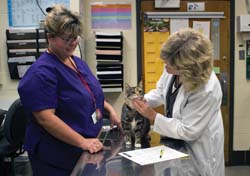
Veterinary hospital subcultures are based not only on rank, but on clinical specialties and the humorous stereotypes associated with them. Equine practitioners joke about companion animal vets, and internal medical specialists joke about egotistical surgeons who are "always naming instruments after themselves." But ultimately, as longtime Dermatology tech Lisa Roundtree says, "You've got to be able to work with everyone. You've got to be able to work with changes. Because every two weeks, you have five to six different sets of students. They all have different personalities. And you just have to learn how to work it and appreciate working and helping people and animals" (Roundtree interview 2007).
Clothing and Identity
Here as in other medical settings, clothing provides important information about rank and sometimes clinical specialties. Clothing for students and veterinarians is largely standardized in clinics because they must look professional. Vet students usually wear khakis or slacks with their short white coats; jeans are discouraged, especially on clinic days when students will be interacting with clients (animal owners). Interns, medical residents, and clinicians wear longer, knee-length white coats, and surgeons wear scrub suits, especially on days they are scheduled to perform surgeries. In 2008, the hospital began an initiative to have members of a particular department easily identifiable by their clothing, so specific colors were assigned to each unit.
Before this practical policy change, hospital clothing sometimes included personal touches. Nurses and vet techs, who work mainly in the "back" or less public areas of the hospital, sometimes wore favorite thematic scrub shirts featuring dogs, cats, and other animals; comic strip characters such as Betty Boop; holiday themes; or hobbies and interests such as NASCAR. Although less evident now, these playful touches brighten the atmosphere of a place dominated by animal health concerns, often serious cases referred to the vet school by local or even out-of-state veterinarians.
Oral Traditions
Veterinary professionals share a range of oral traditions such as work-related slang, metaphors and similes, jokes, and narratives. One of the most ubiquitous forms of verbal folklore is the insider language that members use to communicate with each other. This is not the formal medical terminology that students, clinical, and technical staff learn, but the verbal shorthand they use in speaking with each other. This includes common abbreviated forms of medical terms, acronyms (the word "SOAP" to refer to the evaluations students must give each patient, formed by the first letter of each step: Subjective, Objective, Assessment, Plan), using word particles as complete words ("That cat has an itis," for example, to refer to an inflammation), and humorous terms for kinds of patients or problems. Medical terms such as CAT (Computerized Axial Tomography) scanners beg for visual puns such as pictures of cat heads around the sign for the scanner. Much verbal humor is derived from the various animal substances that veterinary workers routinely encounter in their work, as they are urinated, bled, and defecated on, or sprayed by anal gland exudate.
Hospital speech play sometimes revolves around the metaphors commonly used to describe the clinical signs of illness, which can provide important clues about underlying causes. Food metaphors are common: substances are compared to tomato soup, pea soup, Swiss cheese, fried eggs, cottage cheese, and hamburger meat, or a distinctive odor is referred to as a sour grape smell. These comparisons are also fodder for joking, such as veterinarian's laughing comment, "Oh no, the last thing you want to do is start mixing up vet medicine with food."
When students, nurses, or faculty gather around lunch tables, in treatment rooms, at computer banks, they share stories about their experiences. Common themes include out-of-the-ordinary cases, quirky clients, and unusual patients, which can include almost any species. One vet student described vet school as "very Grey's Anatomy," referring to a then-popular television show in which medical interns all compete to pick up the most interesting and bizarre cases. (The show also annoyed a number of vet students with a story line about one intern's romance with a veterinarian, whom a fellow intern dismissed as "not even a real doctor." They proceeded to pick apart all the things that the show got wrong in its depiction of the fictional vet's work techniques.)
Celebrating Time
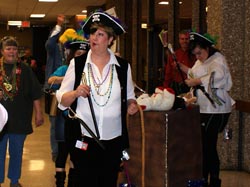
In general, many hospital customs revolve around marking the passage of time and seasonal cycles (Hufford 1989). A number of holidays, for example, are celebrated in the veterinary clinics. Back areas are decorated for Halloween, Thanksgiving, Christmas, and Mardi Gras, and staff members and clinicians sometimes dress in costumes for Halloween or Mardi Gras. For years, there was an "ugly sweater" competition at Christmastime. Special occasions usually include small parties with food; one year, for example, fourth-year students in the Radiology block planned an elaborate Christmas-Hanukah-Kwanzaa feast with latkes, cookies, and other holiday foods.
Like much of South Louisiana, SVM staff celebrate Mardi Gras with purple, green and gold decorations, and king cakes. For several years beginning in 2010, the hospital held its own small Mardi Gras parade through the hallways and courtyard of the hospital, with riders on golf cart floats labelled "Mystic Krewe of Histeaux" (for the Histopathology department) and "Red Hat Ladies" throwing beads along the route. The 2010 parade's king was a stuffed tiger, King Mike VI, representing the university's live tiger mascot.
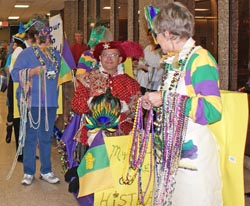
Some of the most anticipated seasonal festivities have revolved around football games, particularly the New Orleans Saints' first (and so far only) Super Bowl championship game in 2010. In the days leading up to the game, Radiology's hallways were decorated with paper cut-outs of Saints players and paper streamers in the team's colors, gold and black. On the Friday before the game, various departments held Saints parties with specially decorated cakes and other party foods. Some faculty members and students also dressed up to show support for the team: an oncology clinician wore a black-and-gold net tutu with a Saints logo to work, and several students wore jerseys printed with their favorite player's number, or black stripes of paint under their eyes. These gestures reflected the fact that veterinary personnel are also members of the larger LSU and Louisiana football-loving community, for whom the Saints' 2010 Super Bowl victory was seen as a symbol of New Orleans' and Louisiana's recovery from Hurricane Katrina five years earlier.
End-of-Block Feasts
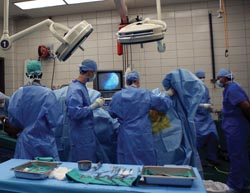
Other celebrations are based not on seasonal cycles but the hospital's own ways of organizing time. Third- and fourth-year vet students' clinical education is divided into a series of two- or four-week "blocks" or rotations through various medical and surgical services such as small and large animal medicine and surgery, dermatology, exotics medicine, anesthesiology, ophthalmology, oncology, cardiology, and so on. Some core fields are required rotations, but students also can choose a few optional blocks. Vet students often compare their experiences and stories of particular clinical rotations, discussing which are fun and which are not, which require the most sleep deprivation, and so on. It is during these clinical rotations that students often discover their own interest in a specialty they had never considered, such as shelter medicine or lab animal medicine.
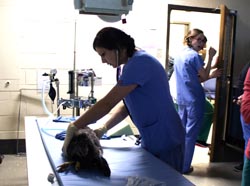
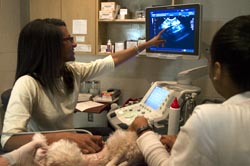
The last Friday of a block, when caseloads are often relatively light, is celebrated hospital-wide with an end-of-block feast. Almost everyone in the hospital brings in some kind of food to share, and each department sets out food out in a conference room or other space. Some areas are widely known for their exceptional efforts; the Radiology Department's staff often sets up a grill outside and cooks platters of barbecued ribs and hamburgers, for instance. Although the clinics' normal activities continue, the hospital takes on a holiday-like feel as employees and students take a break to check which department has the best food, and return with heaping paper plates of freshly-made waffles, enchiladas, potatoes au gratin, macaroni and cheese, and various desserts. These celebrations offer a welcome, if momentary, respite from the typically hectic schedule of the clinics which may not offer opportunities to eat for many hours at a time.
The Human-Animal Bond and Rites of Passage
A number of other ritual traditions reflect the significance of the human-animal bonds that are central to veterinary practice. Most clients are deeply attached to their pets, and veterinary staff and students also become fond of regular patients and their owners. They demonstrate these connections in creative ways, such as specially decorated bandages. Some years ago, when a cat needed a bandage change every two or three weeks after a skin graft, hospital personnel decorated each new bandage with a holiday theme: a red bandage with pink cut-out hearts for Valentine's Day, and seasonal colors for Easter and Christmas. These decorations were intended to cheer up the client and to convey the medical staff's affection for the animal as well.
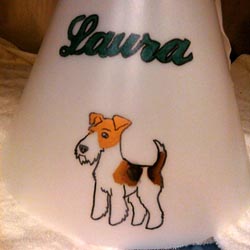
Some rituals mark an important transition in the animal's health care, such as completion of a series of cancer treatments. Oncology technicians celebrate this landmark by sending the pet home wearing a special bandana with handwritten notes of congratulation to the animal—"Way to go! You are the best kitty ever!" Other hospital personnel also gather to congratulate and say goodbye to the pet. These small rituals give owners hope during a difficult time, and recognize the uniqueness and value of the animal. An LSU oncologist remarked that this kind of celebratory rite is not uncommon in animal oncology units, because "the nature of them is to appreciate life."
Rituals are perhaps even more important when a hospital patient dies or must be euthanized, acknowledging the grief of the pet owner and often of the veterinarians and nurses who have cared for it. The profession in general has become more sensitive to the emotional trauma of euthanasia and death not only on clients, but on veterinary workers as well. The LSU small animal clinic now has a special visitation room where pet owners and their pets spend time together before an animal is euthanized, and a grief counsellor is available if needed. After an animal dies, a student or nurse typically makes a plaster imprint of its paw, which is dried and then sent to the owner with a card expressing sympathy. The hospital also offers pet death support groups to help pet owners work through their grief and sense of loss.
Mike the Tiger
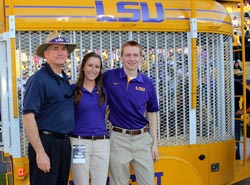
The School of Veterinary Medicine also plays a prominent role in a tradition close to the hearts of the larger LSU community, through its care for the university's beloved tiger mascot. Although LSU has had a live tiger mascot named Mike since 1936, the LSU Athletic Department was responsible for his care for many years. Early student caretakers were members of LSU athletic teams, and later fraternity members (Baker and Bivin 2003). In 1976, soon after the founding of the vet school, the Athletic Department formally transferred responsibility for the tiger to a veterinarian at the new LSU School of Veterinary Medicine. For the last 14 of those years, Dr. David Baker, a vet school faculty member, has been in charge of Mike's medical care, which means being on call around the clock, seven days a week.
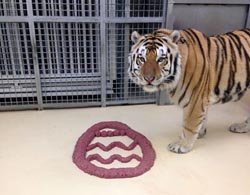
The current mascot is Mike VI, a Bengal-Siberian mix who arrived on campus in 2007 as a two-year-old tiger. He lives in a 15,000 square-foot habitat with a night house, an outdoor habitat featuring a waterfall and pool, a live oak tree, boulders and grass, and other enrichment features. Tremendously popular with students, visitors, and alumni, Mike has his own Facebook page, Twitter account, and "Tiger-cam" stream.
Two vet student caretakers selected by Dr. Baker work as a team to care for Mike daily, watch closely for signs of medical or behavioral problems, provide him with sensory enrichment activities, and accompany him to home football games and other events. Every morning, they inspect the tiger's outdoor environment for any problems or dangers, and then let Mike outside to enjoy his habitat. Each evening, they play with him and bring him indoors to his night house, where they feed him a twenty-five-pound meal of meat and vegetables.
Each team of caretakers, carefully selected by Dr. Baker, works with Mike for two years until they graduate. They develop close bonds with the tiger. Student caretakers create their own games with him, although because of his size, there must always be a fence between Mike and his caretakers. A former caretaker commented that Mike always recognized the sound of her car and the jingle of her keys, and greeted her with "chuffs" of pleasure. She noted that Mike, then a very young tiger, was more playful with her male partner, and more affectionate with her. Current caretakers hide cinnamon essential oil—a smell Mike loves—in his habitat so he will hunt for it. As Mike has grown into an adult tiger weighing more than 400 pounds, however, caretakers must be very careful not to treat him like a pet, although this is difficult at times because he is still so affectionate.
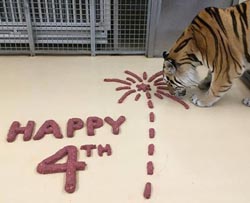
The student caretakers also provide an important educational interface between Mike and the general public. They film short videos of Mike playing, relaxing, and exploring to post on Facebook; answer reader's questions about the tiger; and assume his voice in comments "by" Mike about his activities. In a playful touch aimed more at his Facebook and Twitter followers than at Mike, his caretakers shape his food into symbolic forms such a turkey at Thanksgiving, an Easter egg (and plant colored ice "eggs" in his habitat for him to find and lick) or the initials of an opposing football team on a football weekend, for example.
On home football Saturdays, his vet student caretakers load Mike into a gold-and-purple travel trailer for a "ride-around" of the LSU football stadium, before taking him back to his habitat, putting him inside for the night, and feeding him. This ride-around is a very popular tradition for LSU football fans, but it occurs only if Mike is in the mood to enter his wagon; otherwise, he stays home. Fans sometimes criticize the vet school when Mike decides to miss football games, but Dr. Baker is adamant about never forcing or coaxing the tiger into his wagon. Ensuring Mike's wellbeing is the vet school's top priority, and Dr. Baker comments that if the tiger misses a game, "it's because he didn't want to go. He's a cat. Life is on their terms. They're not dogs. You can't just throw a bone in there and they'll jump in there. Life is on a cat's terms. Any cat person knows that." In the end, he says, people in the LSU community "really care about this animal. . . . He's a family member" (Baker interview 2010). The vet school's responsibility lies in ensuring that Mike the Tiger, as a valued family member, is as healthy and happy as possible.
Hurricane Katrina and Disaster Response: Animal Shelters
Another dramatic example of the LSU School of Veterinary Medicine's impact on the larger South Louisiana community is its role in rescuing and sheltering displaced animals in the wake of Hurricane Katrina in 2005. Failed levees led to massive flooding in Orleans, St. Bernard, and Plaquemines parishes, leaving thousands of residents stranded. Many of those who evacuated left pets and other animals behind, believing that they would return in a few days. Thousands of animals died in the flooding, and tens of thousands more were stranded without food or drinkable water for weeks.
Almost immediately, LSU vet school students and faculty members began efforts to help by setting up phone helplines, establishing temporary shelters for evacuated and rescued animals, providing daily care at the shelters, and—once responders were allowed into flooded regions—rescuing dogs, cats, horses, and other animals. As Ky Mortensen, director of advancement for LSU's Equine Health Studies program, wrote, "What had once been a quiet veterinary school" was "transformed almost overnight into a full-scale emergency response unit" (2008:16).
Equine specialists and staff members quickly organized a public "Horse Hurricane Helpline," spending ten-to twelve-hour shifts fielding calls from horse owners seeking information and help for horses that needed to be evacuated. LSU veterinarians organized a horse shelter at the Lamar-Dixon Exposition Center in in Gonzales, Louisiana, midway between New Orleans and Baton Rouge. Faculty and students provided medical services and daily caretaking to horses there, and as Mortensen notes, "There wasn't a horse brought into the shelter that wasn't touched daily by the hand of an LSU vet student" (2008:71).
Similarly, small animal faculty and vet students were key in setting up a shelter primarily for dogs and cats in Baton Rouge. Residents who evacuated before the storm brought pets with them, but often had no room for them when whole families squeezed into hotel rooms or friends' homes. A temporary pet shelter in LSU Agricultural Center's Parker Coliseum began receiving pets on August 31st, two days after Katrina made landfall. It took in more than 500 animals within two days, and about 2,300 animals passed through the Parker Coliseum shelter before it closed in mid-October of that year (Bacher et al. 2005).
Once authorities began allowing credentialed responders to enter flooded areas, LSU vet school faculty and students worked with the Louisiana State Animal Response Team (LSART) and other agencies to rescue animals from devastated areas, a difficult and dangerous job. Jeff Sirninger, then a pathologist at the LSU vet school, and several vet students went to the New Orleans area to volunteer. They ended up going with armed national Guardsmen in high-tech rescue vehicles to rescue animals in the flooded city. Dr. Sirninger recalled, "You'd go into the Ninth Ward and you'd hear just like . . . the spinning vents in the roof. . . . And it was just a dead zone, you know. And helicopters. It was just very surrealistic" (Sirninger 2006).
Similarly, teams of LSART members and LSU equine experts delivered feed to, and rescued horses and mules from, the flooded parishes. Healthy horses were evacuated to the Gonzales equine shelter, and sick or injured animals were sent to the LSU Vet School for treatment. When Hurricane Rita hit coastal western-central Louisiana on September 24th, these teams also evacuated more than 60 horses inland to a shelter in New Iberia. Ky Mortensen relates some of these equine rescue stories in his 2008 book, Horses of the Storm: The Incredible Rescue of Katrina's Horses.
The LSU School of Veterinary Medicine and its clinics also received many injured or sick animals from flooded New Orleans, and its Intensive Care Unit temporarily doubled in size. The building also became a temporary home for out-of-state veterinarians and technicians who came to Louisiana to assist at the post-hurricane animal shelters. Many slept at the vet school, and second-year students arriving for their classes remember seeing pajama-clad strangers wandering the halls of the school.
Conclusion
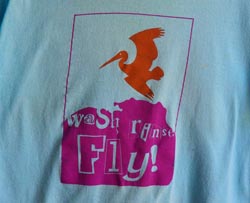
For many LSU veterinarians and students at the time, Hurricane Katrina was a transformative experience. Faculty members involved with the Baton Rouge and Gonzales shelters drew on their experience to deliver conference presentations and publish articles on disaster preparedness and response (Taboada et al. 2006, McConnico et al. 2007). LSU is now considered a leader in this field, and the school continues to work closely with the Louisiana State Animal Response Team to provide animal-related disaster response training and deployment. In the aftermath of the Deepwater Horizon oil disaster in 2010, for example, vet students and personnel worked at the wildfowl rescue center in Plaquemines Parish, decontaminating and nursing oil-sickened birds. A mobile hospital and disaster response vehicle, together with a dedicated team of faculty and students, sits at the ready to respond when needed. It is both a legacy of those days after Katrina and Rita and a reminder that the SVM is watching over its south Louisiana family.
References Cited
Bacher, Renee and Theresa Devlin with Kristine Cologne, Joshua Duplechin, and Stephanie Pertuit. 2005. LSU in the Eye of the Storm: A University Model for Disaster Response. Baton Rouge: Louisiana State University.
Baker, David G. and Sheldon Bivin. 2003. Mike the Tiger: The Roar of LSU. Baton Rouge: Louisiana State University Press.
Becker, Howard S., Blanche Geer, Everett C. Hughes, Anselm L. Strauss. 1976. Boys in White: Student Culture in Veterinary School. New Brunswick, NJ: Transaction Books.
Bosk, Charles L. 1979. Forgive and Remember: Managing Medical Failure. Chicago: University of Chicago Press.
Burson-Tolpin, Anne C. 1982. Pomp and Circumcision: A Parodic Skit in a Medical Community. Keystone Folklore 24, 1:28-40.
___. 1990. "'Fascionomas' and 'Horrendiomas'": The Occupational Language, Humor, and Speech Play of American Physicians. Doctoral dissertation, Department of Folklore and Folklife, University of Pennsylvania.
Coser, Rose Laub. 1959. Some Social Functions of Humor in a Hospital Setting. Human Relations 12:171-182.
Dundes, Alan. 1961. Mnemonic Devices. Midwest Folklore 11(3):139-147.
Gabbert, Lisa and Anton Salud. 2009. On Slanderous Words and Bodies-Out-of-Control: Hospital Humor and the Medical Carnivalesque. In The Body in Medical Culture, ed. Elizabeth Klaver, pp. 209-228. Albany: State University of New York Press.
Guttner, Ginger. September 4, 2014. Mike VI attendance at home football games is entirely up to him. September 4. About SVM, http://www1.vetmed,lsu/SVM/About SVM/News/2014/item 71993.
Herriot, James. 1972. All Creatures Great and Small. New York: St. Martin's Press.
Huber, S.J. 2003. The White Coat Ceremony: A Contemporary Medical Ritual. Journal of Medical Ethics 29:364-366.
Hufford, David. 1989. Customary Observances in Modern Medicine. Western Folklore 48:129- 143.
Hutchens, Casey. 2008. The Lore of Veterinary Medicine: An Exploration of an Unsuspecting Folk Group. Unpublished student paper, Louisiana State University.
LSU SVM. 2004. 8th annual professional coating ceremony program.
___. 2007. HSUS Grants $800,000 to SVM to Launch Companion Animal Health and Spay and Neuter Programs. La Veterinaire Spring 2007: 12.
___. 2008. LSU Veterinary School Acquires Mobile Emergency Response Unit. La Veterinaire May/June: 20-21.
___. 2009a. From the Inside Out: A Chronicle of the Companion Animal Medicine Service. La Veterinaire March/April: 2-7.
____. 2009b. A Moment in the History of Veterinary Medicine. La Veterinaire May/June: 12-13.
___. 2012. Life at the LSU SVM. La Veterinaire 16-17.
___. 2014. Over 8,000 people attend LSU Veterinary School Open House. February 11. http://www1.vetmed.lsu.edu/SVM/About SVM/News/2014/item68415.html.
___. 2015. Open House Booklet. January 31.
LSU School of Veterinary Medicine Bulletin 98(6). 2006. Baton Rouge: Louisiana State University.
McConnico, Rebecca S., Dennis D. French, Bonnie Clark, Ky. E. Mortenson, and Rustin M. Moore, 2007. Louisiana Equine Response in the Aftermath of Hurricanes Katrina and Rita. Journal of the American Veterinary Medicine Association 231(3):384-392.
Mike the Tiger Facebook page. http://www.facebook.com/MikeTigerVI.
Mike the Tiger Twitter account. https://twitter.com/LSUMikeTiger.
Monteiro, Lois A. 1973. Nursing-Lore. New York Folklore Quarterly 29:97-110.
Mortensen, Ky Evan. 2008. Horses of the Storm: The Incredible Rescue of Katrina's Horses. Eclipse Press.
Senior, David. 2006. LSU Emergency Animal Shelter Disaster Response Manual. LSU School of Veterinary Medicine website.
"Kelsie." Special Katrina Pets. Small Animal Intensive Care and Recovery Unit. LSU School of veterinary Medicine. http://www.vetmed,lsu.edu/vth&c/keslie.htm. Accessed on December 7, 2007.
Taboada, Joseph; David Senior; Jeff Sirninger; Rebecca McConnico; and Susan Eddlestone. 2006. Hurricane Disaster Response: What Happened in Louisiana? What Did We Learn? Presentation, American College of Veterinary Internal Medicine 24th Annual Forum, Louisville, Kentucky. June 3.
Trout, Nick. 2008. Tell Me Where It Hurts: A Day of Humor, Healing, and Hope in My Life as an Animal Surgeon. New York: Broadway Books.
Ware, Carolyn E. 2011. "Rabid Cows and Undead Dogs: Storytelling in Veterinary Medicine." Contemporary Legend Series 3 (1):29-43.
Weisert, Hilde and Elizabeth Arnold Stone, eds. 2012. Animal Companions, Animal Doctors, Animal People: Poems, Essays, and Stories on Our Essential Connections. Guelph, Ontario: Ontario Veterinary College.
Interviews
Baker, David. October 12, 2010. Interview with Carolyn Ware.
Boehm, Chris. June 30, 2006. Interview by Carolyn Ware and Beth Tomlinson.
Eddlestone, Susan. June 16, 2006. Interview with Beth Tomlinson and Carolyn Ware.
Foil, Carol. June 7, 2006. Interview with Beth Tomlinson and Carolyn Ware.
Griffenhagen, Gregg. July 28, 2006. Interview with Carolyn Ware.
McConnico, Rebecca. December 13, 2005. Interview with Beth Tomlinson and Carolyn Ware.
Mitchell, Mark. January 27, 2007. Interview with Carolyn Ware.
Rattray, Tamara. September 1, 2006. Interview with Beth Tomlinson and Carolyn Ware.
Roundtree, Lisa. November 30, 2007. Interview with Carolyn Ware.
Senior, David. July 18, 2006. Interview with Beth Tomlinson and Carolyn Ware.
Sirninger, Jeff. July 18, 2006. Interview with Beth Tomlinson and Carolyn Ware.
Taboada, Joseph. November 29, 2007. Interview with Carolyn Ware and Beth Tomlinson.



